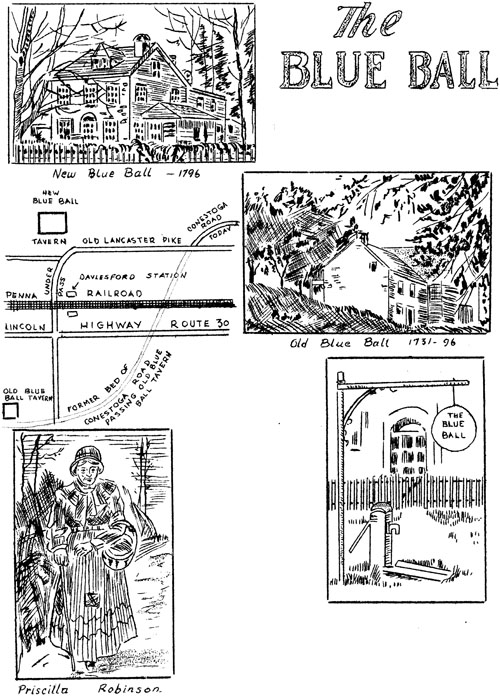|
Home : Quarterly Archives : Volume 2 |
Tredyffrin Easttown Historical Society |
|
Source: April 1939 Volume 2 Number 2, Pages 26–28 The Blue Ball Tavern at Daylesford
New Blue Ball - 1796, Old Blue Ball 1731 - 96, The Blue Ball, Priscilla Robinson In the little valley, just south of what is now Daylesford Station of the Pennsylvania Railroad, is the Old Blue Ball Tavern. It is Mrs. Olney Croasdale's home now -- a peaceful, pretty place, white with bright blue paint. Only the rear, the south end of the old inn remains now. And the big old barn is gone. When the spring on the east was repaired in 1936, old stone work was found. That spring has meant refreshment to many people for years. The Blue Ball is one of the oldest of the old taverns in Pennsylvania. It was called the Half-Way House for a while, half way between the Brandywine and the Schuylkill and half way between the two Church of England Parishes -- St. David's at Radnor and St. Peter's in the Valley. The road on which the old inn stood was once an Indian Trail. At that time, it was a rough pathway, fit only for pack horses. The Half-Way House became the Blue Ball in 1735. There are records of a succession of landlords until about 1793, when the road-way was changed, isolating the tavern, and the "New Blue Ball" was built at that time. These are the landlords of the original house: 1735, Robert Richardson; 1741, Thomas McKean, an uncle of Governor McKean; 1752, Conrad Young, who called the house the King of Prussia. It was Blue Ball again, with Thomas Wilkinson as host. He had licenses 1757 and 1759. At this time the Blue Ball was the mustering place of the troops of General Forbes. The troops were marched to Ohio for the French and Indian Wars. (Sachse.) At this time, too, the Appraiser, a very unpopular person who made military requisitions, had his headquarters here in 1759. Dr. Bernhard Van Leer bought the property, 209 acres, and leased it in 1760 to Benjamin Weatherby. Weatherby was host until 1766. His widow carried on until 1771, when Phillip Wayne Upright applied for a license. Among the "signers" for Upright were Isaac and Anthony Wayne. Phillip Upright had his troubles. He was "despoiled of his goods, by the hireling foe". Captain Reese had the Blue Ball in 1778. There is noted in the "Remembrances of Christopher Marshall a note 9-12-1778. Reached Capt. Reese's tavern, at the Blue Ball by dusk. Here we took up our residence for the night. We drank coffee for supper and slept in our great coats, stockings, etc., for fear of fleas and bugs!" 1782-87 -- John Phillips 1788-92 -- Moses Moore 1793-96 -- John Llewellyn, at which time the new road came into use and business was lost. As the old Blue Ball lost its business when the road was changed so the newer one suffered when the railroad came in the '30's. From about 1834 to 1836 horses were used to pull the trains. Then when steam was used, Priscilla Robinson, who was land lady at the time lost her temper. There was that railroad, spoiling her business. Paoli Inn flourished and the Blue Ball lost. She would go out and scold, berating, the crews of the trains. The engineer would shriek his whistles back at her. Once Prissy's calf was killed on the tracks. She demanded damages at once and when her claim was not satisfied she spread what was left of that calf on the rails, and the trains could not go, on the slippery tracks; no trains did go until that claim was settled to Prissy's complete satisfaction. Of the newer Blue Ball, now the John Croasdale house, many stories have been written. Perhaps most of the rougher legends really belong to the first Blue Ball. The newer Blue Ball came into use about 1790. There was much activity on the great new road. More than 150,000 bushels of wheat, for instance was hauled, from the Susquehanna into Philadelphia in that year. It was estimated that the cost of transporting one bushel, was 2 pounds 6 pence. Salt, liquor, other things were carried on the return trip. Sachse says "The wear and tear on the teams and wagons was enormous. The terrible condition of the road, especially during a wet season, can now hardly be described; the ruts in the miry road often hub deep" --It was not unusual for wagons to freeze fast in the ruts and remain until they could be gotten out in the coming spring. Many stories are told of Prissy. She kept the Blue Ball for fifty years and saw her trade slip away, and her inn grow old and shabby. People were afraid of her, and the house grew to have the reputation of being haunted. But people who knew Priscilla Robinson deny these strange stories. Perhaps she was just a disappointed, cross old woman. Now the children in the neighborhood come and stay on the porch, or inside when the weather is bad, until the school busses come for them. The roads are good, and no one is afraid. But the stories cling to the old house. |
